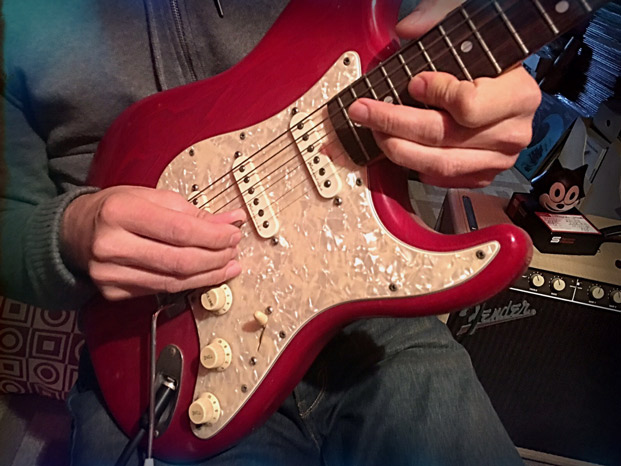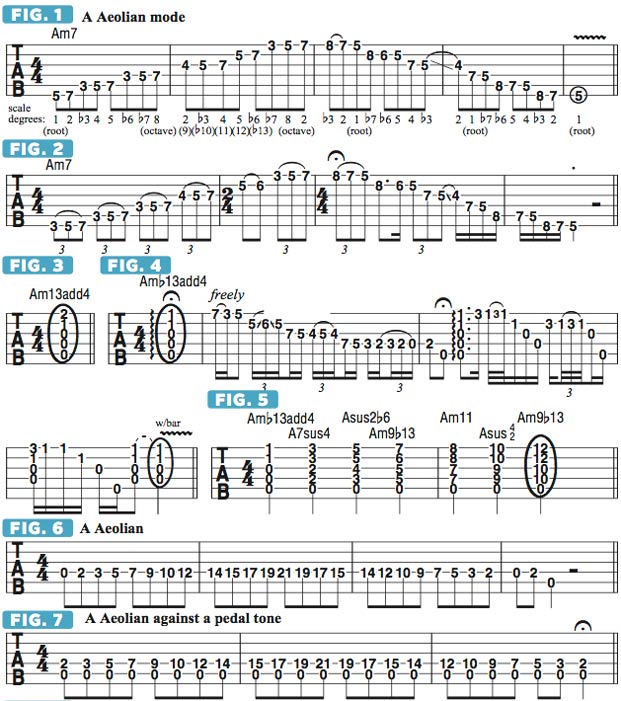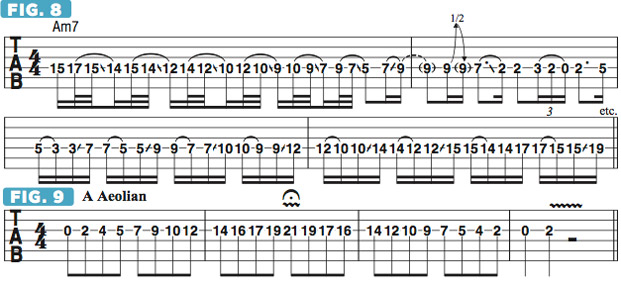Devising Creative Chord Patterns and Voicings from the A Aeolian Mode

Often when jamming, guitarists are required to play rhythm accompaniment for long stretches of time over repeating chord progressions or vamps. This can be tedious and monotonous for the player (as well as the listener), but it doesn’t have to be.
By broadening your rhythm guitar chops in creative and inventive ways, you can play rhythm guitar with as much freedom as you play a solo. The challenge is to come up with guitar parts that are not only rhythmically solid but also melodically interesting.
Which brings us to the subject of this month’s lesson. In my last column, I demonstrated how to utilize modal structures to connect chord voicings up and down the fretboard.
I started with an interesting-sounding, unresolved chord, Am13add4, built from stacked fourths—each successive chord tone being a fourth higher than the previous note—as they occur in the A Dorian mode (A B C D E F# G).
In the process, we discovered some cool and unusual chord voicings by moving up and down the neck on a given group of strings while staying diatonic to (within the scale structure of) the Dorian mode. This month, we’ll utilize a similar approach with another widely used mode, A Aeolian.
A Aeolian comprises the notes A B C D E F G and is nearly identical to A Dorian, the only difference being the sixth scale degree. In A Dorian, it is F#, the major sixth; in A Aeolian, the sixth is one half step lower, F, the minor, or flat, sixth. The intervallic spelling of A Aeolian is 1(root) 2 b3 (flat three) 4 5 b6 (flat six) b7 (flat seven). As you will discover, changing this one note will result in a combination of some chord voicings that sound very different than those built from A Dorian, while certain other voicings will remain identical.
FIGURE 1 depicts A Aeolian played in third-fifth positions. There’s a bit of a fret-hand stretch required when playing on the bottom three strings, as the index finger frets notes at the third fret, the middle finger frets the fifth fret, and the pinkie reaches up to the seventh fret. Be sure to keep your fret hand as relaxed as possible at all times, with the thumb positioned squarely on the back of the neck and the fingers directly above their assigned frets. Also, strive to keep the fingers parallel to the frets. Practice this scale pattern up and down in order to memorize its structure and familiarize yourself with the mode’s musical quality.
All the latest guitar news, interviews, lessons, reviews, deals and more, direct to your inbox!
Before moving into chord patterns, try playing “freely” through the mode in this area of the fretboard, as illustrated in FIGURE 2. The three-notes-per-string approach is emphasized here, which is very helpful to use in the formation of legato patterns that are performed with hammer-ons, pull-offs and finger slides. As always, practice the scale patterns and runs using different pick-hand approaches, such as starting with picking every note and then adding pull-offs, hammer-ons and slides wherever it feels comfortable to do so.
FIGURE 3 illustrates the Am13add4 stacked-fourths chord voicing that we started on with the A Dorian mode last month. If we switch F# to F, we get the chord shown in FIGURE 4, Amb13add4. Strum this chord, and then try playing freely through the A Aeolian mode in the manner demonstrated in the sample single-note solo. The chord’s unresolved sound lends itself well to melodic patterns that reflect a similarly unresolved quality through the emphasis of the chord tones of Amb13add4: A D G C F.
Other chord forms that “live” in A Aeolian can be generated by simply moving up to the next scale degree on each string in lock-step fashion. FIGURE 5 illustrates the series of chords formed in this manner when moving to each successive scale degree on the top four strings, played along with an open A string, which serves as a pedal tone. As you play through this progression of voicings, do your best to memorize the chord shapes, or “grips.” You’ll notice that there are only four different shapes, and it is very useful to drill on moving from one shape to the next so that you will be able to burn them into your visual, auditory and muscle memory and locate them as quickly as possible.
It’s very helpful to play A Aeolian up and down the entire length of each individual string, just as we did last month with A Dorian. FIGURE 6 illustrates A Aeolian ascending and descending the D string, and FIGURE 7 details each of these notes played in tandem with the open A string. The run in FIGURE 8 is based on a repeated melodic motif that moves up and down the D string in a pattern used typically in many guitar solos.
Let’s now apply this same approach to the top three strings. FIGURES 9-11 detail the A Aeolian mode played up and down the G, B and high E strings, respectively. Once you’re familiar with these patterns, try improvising original melodies along each string in the manner of FIGURE 8.
Now that you’re familiar with A Aeolian played on each string, let’s go back to our Amf13add4 stacked-fourths chord voicing and proceed to “walk” up each string in four-part harmony, as shown in FIGURE 12. Notice how each shape is altered slightly as you progress up the neck. The best way to get these chord shapes under your fingers is to focus on one area of the fretboard at a time, moving back and forth between three or four voicings only. FIGURE 13 offers a structured way to use this approach in the study of A Aeolian-based voicings in various area of the fretboard.


Guitar World Associate Editor Andy Aledort is recognized worldwide for his vast contributions to guitar instruction, via his many best-selling instructional DVDs, transcription books and online lessons. Andy is a regular contributor to Guitar World and Truefire, and has toured with Dickey Betts of the Allman Brothers, as well as participating in several Jimi Hendrix Tribute Tours.

